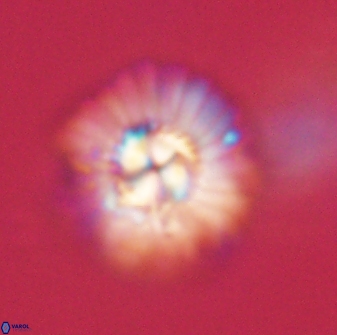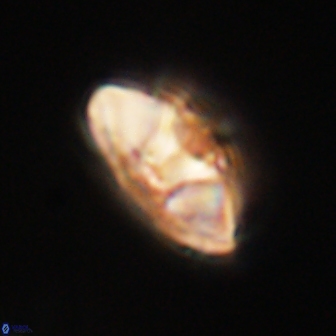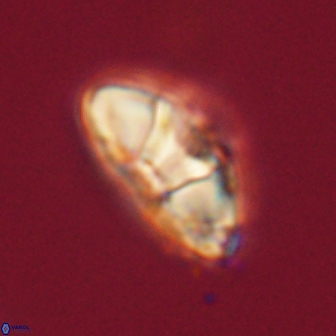Carlamuelleria tuezueniorum
Carlamuelleria tuezueniorum Varol, 2023
Large (8.0–12.0 μm) species of Carlamuelleria possessing a non-birefringent distal shield with 23 to 40 segments, a birefringent tube cycle with the often serrated periphery and a vestigial, diminutive proximal shield.
In honour of Dinçer Ates¸ Tüzün and Ruhiye Tüzün, Geologists, Ankara, Turkey.
Diameter of the distal shield: 9.43 μm (measured in plan view in phase-contrast), the maximum thickness of the distal shield: 3.97 μm (measured in side view in cross-polarised light), the diameter of the tube cycle: 3.88 μm (measured in plan view in phase-contrast).
The distal shield is lenticular in shape, having a shallow depression on its less convex side, and consists of about 23–40 segments. The tube cycle and vestigial diminutive proximal shield combination resembles a brandy goblet-shaped structure in side view. The tube cycle is often flush with the distal end of the shield but extends above it by a fraction (Plate 7, Figs. 4, 8, and 10 in Varol, 2023).
In cross-polarised light, identifying the curved direction of the extinction lines is difficult. The inclined (oblique) extinction lines of the proximal side. With the gypsum plate inserted, the blue interference colours are diagonally aligned on the proximal and distal sides of the tube cycle (P7. 4, Figs. 14, 16; Plate8, 14, 16 in Varol, 2023). The blue sectors of the tube cycle and shield are aligned in opposite directions. The entire specimen appears birefringent in side view.
In plan view, Carlamuelleria tuezueniorum is distinguished from Carlamuelleria bramlettei by having more segments in its shield (>23 segments). It differs from the subcircular Carlamuelleria karacuhae by having a circular tube cycle. In contrast, the latter has an elliptical tube cycle.
Carlamuelleria tuezueniorum is easily identified from Davidbukrya species in side view by having a brandy goblet-shaped structure formed by the arrangement of the tube cycle and the vestigial, diminutive proximal shield. The proximal shield is absent in Davidbukrya.
After mapping its optical properties, Carlamuelleria tuezueniorum is differentiated from Davidbukrya and Markalius in plan view by having a diagonal interference colour alignment in the tube cycle. In contrast, in their tube cycle, Davidbukrya and Markalius exhibit an axial interference colour alignment (i.e., a blue sector horizontal on the distal side and vertical on the proximal side). Moreover, Carlamuelleria tuezueniorum is consistently and confidently differentiated from Markalius in side view by having a vestigial, diminutive proximal shield, whereas the latter has a spaced proximal shield.
Varol, O. 2023. New paleocene calcareous nannofossils: Carlamuelleria, Davidbukrya, Mauriceblackia, Noelia and Senelia. Marine Micropaleontology. 180: 1-41.



